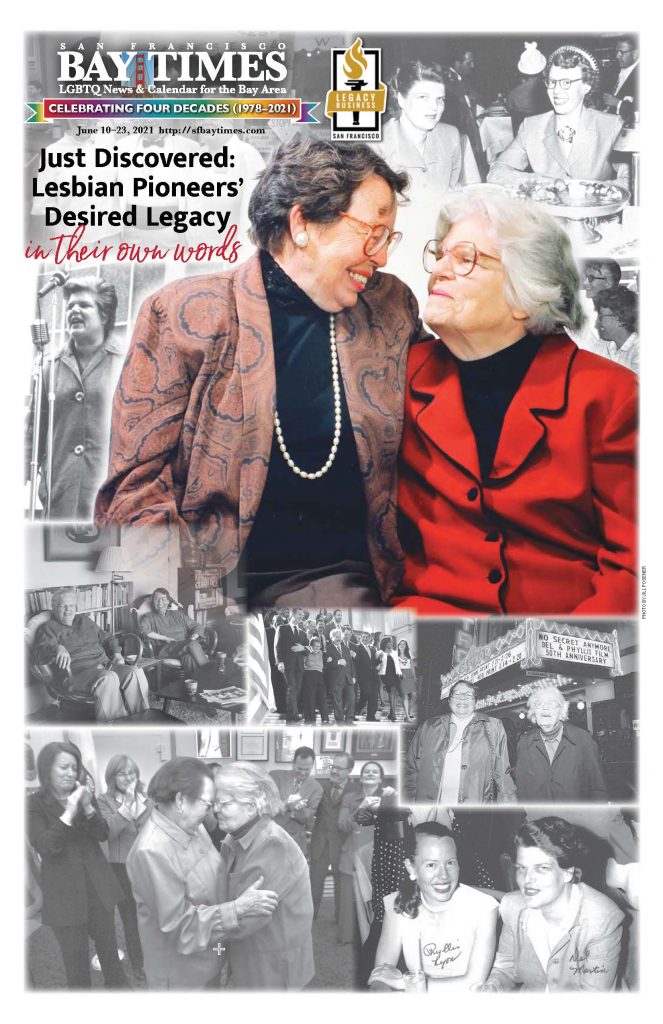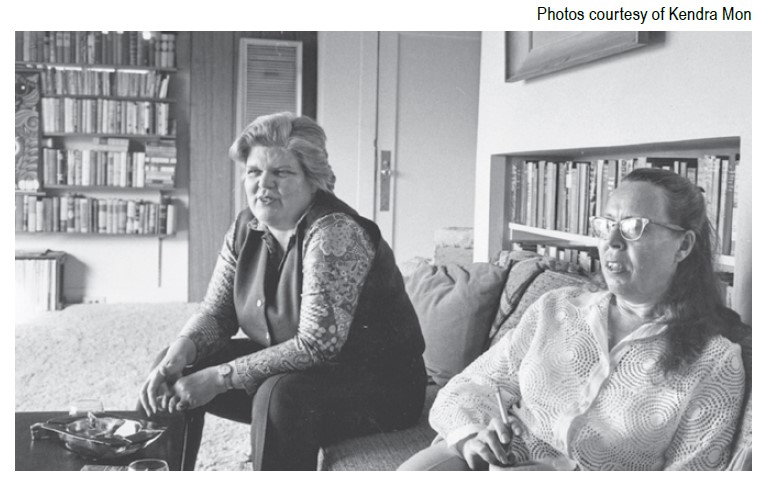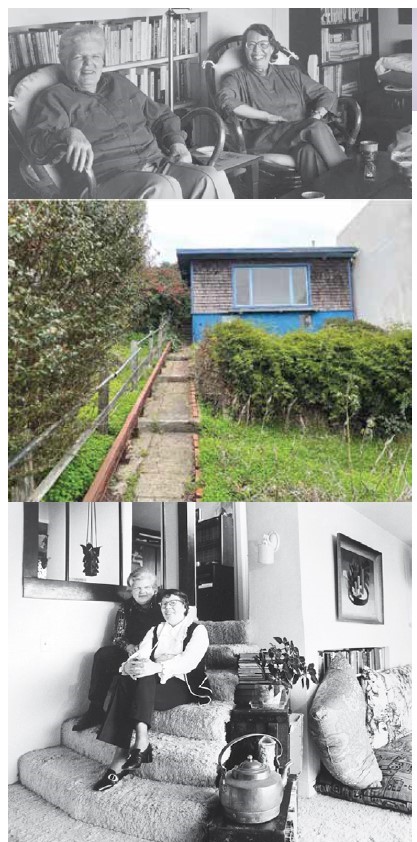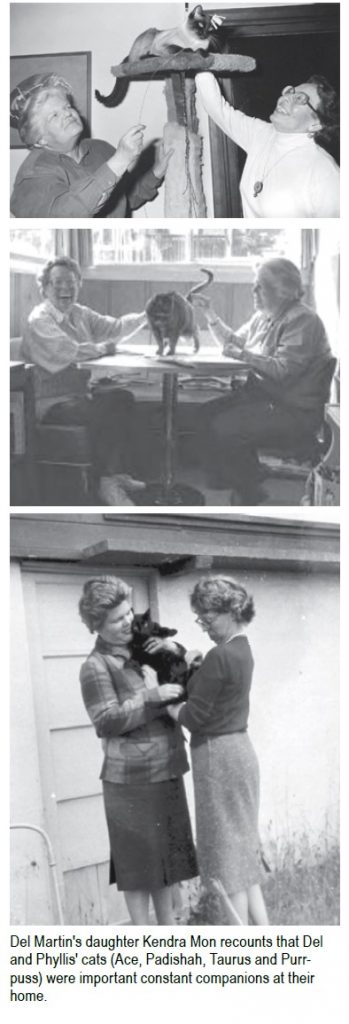
When Phyllis Lyon and Del Martin as a couple purchased 651 Duncan Street in San Francisco in 1955, they both treasured the large front window that, on a clear day, offered a view that extended all the way to Alcatraz and even to the Campanile at UC Berkeley. Phyllis in the evenings nearly always sat closest to the window, with Del close by.

The large window, however, posed concerns, since passersby could look inside the home and observe not only its lesbian occupants, but also houseguests who might include Black civil rights leaders, gay men, other lesbian activists, and any number of people whose very existence was threatened by laws at the time. For example, a “sexual perversion” executive order issued by President Dwight Eisenhower just two years earlier permitted the firing of homosexual federal workers. Arrests for sodomy then were common.
One day, however, Phyllis decided to take the curtains down.

“She and Del lived openly and stopped hiding behind the curtains,” Kendra Mon, Del’s daughter, told the San Francisco Bay Times. “Phyllis loved to tell that story—and she loved the view from that window. Both she and Del couldn’t imagine being away from San Francisco and the view for long.”
Comforting Routines
Mon recalled that her mother and Phyllis (whom she viewed with affection as mother, too) would enjoy breakfast together at a small kitchen banquette. Del would sit on a bench and Phyllis on a chair opposite her, where they would enjoy coffee, juice, and breakfast, read the newspaper, and talk about articles that interested them.
The space was also used for card games like Solitaire. A pegboard rested between them where they kept track of who was winning.
Books were important in the Lyon-Martin household. The couple wrote them, such as the groundbreaking book Lesbian/Woman, and they read voraciously as well—everything from political-themed tomes to favorite mysteries.
Cocktail hour was at 5 pm. Both enjoyed cooking: Del was famous for her potato salad, but Phyllis was the more frequent chef in residence.
“I never had a fresh mushroom until I met her,” Mon said of Phyllis. “She followed recipes, learned French cooking, and had all sorts of cookbooks.”
For a quiet evening at home, the couple would sit together downstairs and read, watch television, or just snuggle and enjoy that aforementioned stellar view.

A Fondness for Felines and Names
Cats Padishah and Ace became part of the family.
“They [Del and Phyllis] took time to find the name ‘Padishah,’ which refers to an emperor,” Mon said. In Turkish, the word with a slightly different spelling denotes sultans of the Ottoman Empire. Padishah also was a name made famous years later in the science fiction novel Dune by Frank Herbert.
Ace, in turn, was sleek and black. Later, Taurus and Purrpuss were brought into the feline fold.
Del and Phyllis named their home “Habromania Haven.” The word habromania comes from the field of science and refers to “a form of delusional insanity in which the imaginings assume a cheerful or joyous character.”
The couple had a rental house in Jenner that they also named: “Outer Sanctum.”
They additionally over the years named their cars.
Where Time Stood Still
Mon fondly recalled holidays spent at the home. A mixture of community leaders, friends, neighbors, and family members might stop by for Phyllis’ delicious meals, drinks, and dancing.
“I remember joy and dancing,” Mon said.
At some point in the evening, the game Tripoli would be brought out in the living room. Both Del and Phyllis enjoyed the game and would try to outwit each other. (Tripoli is a contemporary version of the 500-year-old European game Poch.)
“I never felt like time was an issue when I was at 651 Duncan,” Mon shared. “It always felt like we had plenty of time and were never pressured. We lived in the moment.”
She added, “I’ve begun to think of 651 Duncan as ‘The Little House that Could and Did.’ It nourished my moms, gave them great pleasure, hosted many events, connected them across generations, housed their many books and beloved
cats, inspired a new care system, and provided the financial means to care for Phyllis [in her later years] so that she could continue to enjoy being there.”
On May 21, Mayor London Breed signed an ordinance establishing the landmark status of 651 Duncan Street in San Francisco. Lesbian and civil rights activists Del Martin (1921–2008) and Phyllis Lyon (1924–2020) purchased the home at the Noe Valley property in 1955 and lived there until they both passed away. The home is now the first piece of lesbian history to receive landmark status in the western U.S.
All ordinances take legal effect 30 days after the Mayor’s signature, so 651 Duncan’s landmark status will be official and final on June 20.
The ordinance holds that the house was deemed eligible for local designation “as it is associated with events that have made a significant contribution to the broad patterns of San Francisco history and with persons significant to San Francisco history. Specifically, designation of Lyon-Martin House is proper[ly] given association with the history of development of homophile organizations in San Francisco, specifically the Daughters of Bilitis, the first lesbian-rights organization in the United States, and as the longtime home of pioneering lesbian-rights activists, Phyllis Lyon and Del Martin. The period of significance is 1955 to 2020.”
Christina Morris, a Senior Field Director at the National Trust for Historic Preservation and the lead on the National Trust’s Where Women Made History campaign, explained to the organization Saving Places why the Lyon-Martin house has attracted widespread attention:
“This house may be small, but it has outsized significance stretching far beyond San Francisco or California. Phyllis and Del’s lifetime of activism battling discrimination against the LGBTQ communities and violence against women has changed thousands of lives. This is a place where women had a national impact on LGBTQ civil rights on par with Stonewall, and it deserves that same level of respect and recognition.”
Beyond the home’s landmark status, its future remains in question since planning would have to take into account the current owner, who purchased the home on September 4, 2020, and many other considerations. Numerous ideas have been proposed, such as preserving the house for visitors interested in its history while keeping in mind that the home is located in a quiet, residential neighborhood. Another proposed idea is using the home as housing for a scholar, similar to temporary university-provided housing, which would allow many individuals over the years to gain knowledge and inspiration of Martin and Lyon within such a personal, intimate setting.
The San Francisco Bay Times will continue to follow this story and provide any updates as they become available. For more information about the significance of the Lyon-Martin house: https://tinyurl.com/sjb84upj
Published on June 10, 2021
Recent Comments